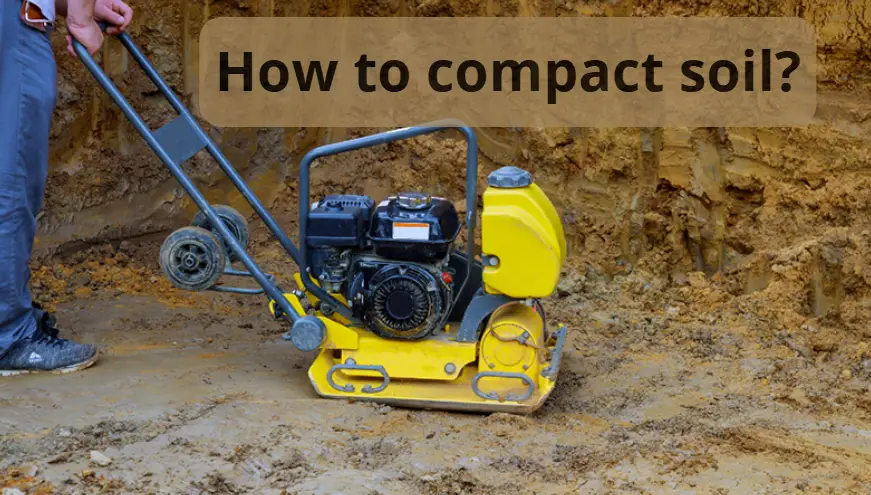Table of Contents
How to compact soil?
To compact soil effectively, there are several methods that vary depending on the size of the area, soil type, and compaction level needed. Here are some common methods:
1. Hand Tamper
- Best for: Small areas, like flower beds or garden paths.
- Method: A hand tamper is a heavy metal plate attached to a long handle. Use it by lifting it slightly and then letting it drop to compact the soil.
- Tip: This method is labor-intensive but works well for smaller projects.

2. Plate Compactor (Vibrating Plate)
- Best for: Medium-sized areas, such as patios or walkways.
- Method: A plate compactor is a machine with a flat metal plate that vibrates and moves over the soil, compacting it as it passes.
- Tip: Move the plate compactor back and forth over the soil in overlapping passes to ensure even compaction.

3. Sheepsfoot Roller
- Best for: Large areas, especially with cohesive soils like clay.
- Method: This heavy roller has bumps (or “feet”) that penetrate and compact the soil, especially useful for binding clay soils.
- Tip: These are often large and may require a tractor to pull.

4. Vibratory Roller
- Best for: Large areas, with granular soils like sand or gravel.
- Method: A vibratory roller is similar to a sheepsfoot but has a smooth drum that vibrates to compact the soil, ideal for sand and gravel bases.
- Tip: These are used on roads and large areas where uniform compaction is needed.

5. Watering
- Best for: General use in gardens and lawns.
- Method: Lightly water the soil to add moisture, which can help particles settle and compact naturally. Avoid over-watering, which can make the soil too soft.
- Tip: This method can supplement mechanical compaction for better results.

Key Tips for Compaction:
- Layered Compaction: If you’re working with deeper soil, compact in layers (often 6-8 inches deep at a time). This ensures the entire depth is compacted uniformly.
- Optimal Moisture Content: Soil compacts best at a certain moisture level. For most soils, slightly damp but not saturated soil is ideal.
- Avoid Over-compacting: Especially with heavy equipment, as this can damage soil structure and drainage.
What does it mean to compact the soil?
To compact the soil means to densify it by reducing the spaces (or pores) between soil particles. This process involves applying pressure to remove excess air, which makes the soil denser and less compressible. Compacting soil is commonly done to create a stable, solid base that can support structures, resist erosion, and reduce future settlement.
Why is it necessary to compact the soil?
Compacting soil is essential in various applications, from construction and landscaping to gardening, to achieve stability, support, and long-term durability. Here are the main reasons why soil compaction is necessary:
1. Prevents Soil Settlement
- Loose soil can settle over time, which can cause uneven surfaces, sinking foundations, and cracks in structures. Compacting helps reduce the air gaps in the soil, creating a more stable foundation and minimizing the risk of settlement.
2. Increases Load-Bearing Capacity
- Properly compacted soil can support more weight, which is crucial in construction. For instance, buildings, roads, and pavements require a solid base to handle the weight of the structures or the traffic that will be on them.
3. Reduces Soil Erosion
- Compacted soil is less likely to be eroded by wind or water. By making the soil denser, compaction helps protect against erosion, which can wash away or destabilize un-compacted soil.
4. Improves Stability and Reduces Swelling/Shrinkage
- Certain soils, like clay, can swell with water or shrink when dry, leading to movement that may damage foundations, roads, or sidewalks. Compaction minimizes the soil’s tendency to absorb excess water, reducing the risk of this movement.

5. Enhances Soil’s Structural Integrity for Roads and Pavements
- Roads, parking lots, and pathways require a strong base to prevent cracking and shifting. Compacted soil provides a stable, even surface that reduces the wear and tear on these structures, extending their life.
6. Improves Drainage Control
- Compaction affects how water moves through the soil. While overly compacted soil can reduce water infiltration, controlled compaction can create a stable layer beneath porous surfaces, directing water flow and reducing puddling or waterlogging in certain applications.
7. Prepares Soil for Foundations
- For buildings, compacted soil provides a reliable base to prevent structural issues. Without compaction, the uneven movement of the soil could compromise the foundation’s integrity, leading to damage and costly repairs.
8. Increases Plant Growth Success (In Landscaping)
- While overly compacted soil isn’t ideal for roots, controlled compaction can be beneficial when preparing a site for landscaping, ensuring that plants have a stable environment with fewer air pockets that can cause instability in root systems.
Pros and Cons of soil compaction
Pros
- Prevents Soil Settlement
Compacting soil reduces air pockets, minimizing long-term soil settlement that can lead to uneven surfaces and structural issues. - Increases Load-Bearing Capacity
Compacted soil provides a strong base, essential for supporting structures, roads, and pathways without shifting or sinking. - Reduces Soil Erosion
Compacted soil is less susceptible to being washed or blown away, preserving the soil’s integrity and protecting nearby ecosystems from sedimentation. - Improves Soil Stability and Reduces Swelling/Shrinkage
Certain soils, like clay, can swell with water or shrink when dry. Compaction stabilizes these soils, making them less prone to movement that could damage structures. - Enhances Structural Integrity of Roads and Pavements
Compacted soil provides a stable base for roads, paths, and other structures, helping to reduce cracking and other issues over time. - Controls Water Movement
In construction and landscaping, compacted soil helps manage water flow, directing it away from structures and preventing water pooling.
Cons
- Reduced Soil Aeration
Compaction decreases air space in the soil, limiting oxygen for plant roots and soil organisms. This can harm plants and beneficial microbes. - Poor Water Infiltration and Drainage
Compacted soil can impede water penetration, leading to runoff, erosion, and potential flooding, especially in areas where drainage is critical. - Inhibited Root Growth
Dense, compacted soil makes it difficult for roots to penetrate, resulting in shallow root systems that are less stable and more vulnerable to drought. - Decreased Soil Fertility
Compaction affects soil microbiology and reduces nutrient availability, negatively impacting soil fertility and plant health. - Increased Runoff and Erosion
Less water infiltrates compacted soil, leading to higher runoff and increased erosion, which can degrade nearby ecosystems and reduce soil quality. - Higher Soil Temperatures
Compacted soil lacks insulating air spaces, leading to higher soil temperatures during hot weather, which can harm roots and soil organisms. - Difficult to Reverse
Once soil is compacted, it can be challenging and costly to restore its natural porosity, often requiring mechanical intervention like tilling or aeration. - Reduced Agricultural Yield
In farming, compacted soil can limit crop growth due to restricted root development, impaired water absorption, and reduced nutrient uptake. - Negative Impact on Biodiversity
Compaction can disrupt natural habitats, harming soil-dwelling organisms like earthworms, which are essential for maintaining healthy soil. - Increased Energy Costs in Agriculture
Compacted soil requires more energy to till or aerate, increasing fuel and labor costs in agricultural settings.
6 Types of Plate Compactor
1. Single-Plate Compactor
- Description: Has a single flat plate and operates by vibrating in a single forward direction.
- Best For: Light-duty tasks, such as compacting sand, gravel, or asphalt in small to medium areas.
- Pros: Lightweight, easy to maneuver, and ideal for compacting granular soils.
- Cons: Limited compaction depth and unsuitable for cohesive soils (e.g., clay).

2. Reversible Plate Compactor
- Description: Can move forward and backward, thanks to a more advanced vibration mechanism.
- Best For: Medium to heavy-duty applications, where deeper and more uniform compaction is needed.
- Pros: Offers greater control, suitable for larger areas, and works well on various soils.
- Cons: More expensive and heavier than single-plate compactors, requiring more skill to operate.

3. High-Frequency/Heavy-Duty Plate Compactor
- Description: A powerful machine with higher vibration frequency, designed for intensive, deep compaction.
- Best For: Large construction projects, including road building and foundation work, where deep compaction is needed.
- Pros: Compacts soil deeply and uniformly, ideal for high-load-bearing requirements.
- Cons: Very heavy and expensive, usually reserved for professional construction projects.

4. Gas-Powered Plate Compactor
- Description: Powered by a gasoline engine, this type is one of the most common and versatile for a variety of projects.
- Best For: Outdoor projects, where mobility and power are needed.
- Pros: Strong, reliable power, and suitable for various applications.
- Cons: Requires regular maintenance and emits exhaust fumes, so it’s unsuitable for indoor use.

5. Electric Plate Compactor
- Description: Powered by electricity rather than gas, typically smaller and lighter.
- Best For: Indoor or smaller projects where exhaust fumes are an issue.
- Pros: Emission-free, quieter than gas models, and often easier to maintain.
- Cons: Limited by cord length (or battery life, if cordless), and less powerful than gas compactors, making it unsuitable for heavy-duty work.

6. Hydraulic Plate Compactor
- Description: Operates via hydraulic systems, often used as an attachment on excavators.
- Best For: Large construction sites and projects with hard-to-reach areas, such as trenches and around pipelines.
- Pros: Provides strong, consistent compaction with high force and depth, suited to challenging terrain.
- Cons: Requires an excavator or other machinery to operate, making it costly and specialized.

FAQ
What is the cheapest way to compact soil?
Foot Compaction
Cost: Free.
Best for: Small, accessible areas like garden beds, around plants, or smaller patches.
Method: Simply walk over the soil, making sure to step down firmly. You can use a piece of plywood and walk on it to distribute your weight evenly and compact a larger area at once.
READ ALSO: How to use soaker hose for foundation?

